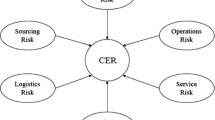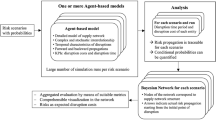Abstract
This paper addresses the problem of quantifying and modeling financial institutions’ operational risk in accordance with the Advanced Measurement Approach put forth in the Basel II Accord. We argue that standard approaches focusing on modeling stochastic dependencies are not sufficient to adequately assess operational risk. In addition to stochastic dependencies, causal topological dependencies between the risk classes are typically encountered. These dependencies arise when risk units have common information- and/or work-flows and when failure of upstream processes imply risk for downstream processes. In this paper, we present a modeling strategy that explicitly captures both topological and stochastic dependencies between risk classes. We represent the operational-risk taxonomy in the framework of a hybrid Bayesian network (BN) and provide an intuitively compelling approach for handling causal relationships and external influences. We demonstrate the use of hybrid BNs as a tool for mapping causal dependencies between frequencies and severities of risk events and for modeling common shocks. Monte-Carlo simulations illustrate that the impact of topological dependencies on triggering overall system breakdowns can be substantial.
Similar content being viewed by others
References
P. Embrechts, F. Lindskog, and A. J. McNeil, “Modelling dependence with copulas and applications to risk management.” In S. T. Rachev (ed.), Handbook of Heavy Tailed Distributions in Finance, published by Elsevier/North-Holland, Amserdam, 2003.
A. Frachot, O. Moudoulaud, and T. Roncalli, “Loss distribution approach in practice.” In M. K. Ong (ed.), The Basel Handbook: A Guide for Financial Practictioneers, pp. 369–398, Risk Books: London, 2004.
A. Frachot, T. Roncalli, and E. Salomon, “The correlation problem in operational risk,” Groupe de Recherche Opérationnelle Group Risk Management, Crédit Agricole SA. Working paper, 2004.
D. G. Hoffman, Managing Operational Risk: 20 Firmwide Best Practice Strategies, Wiley Frontiers in Finance, John Wiley & Sons, Inc.: New York, 2002.
S. L. Lauritzen, “Propagation of probabilities, means, and variances in mixed graphical association models,” Journal of American Statistical Association vol. 87 no. 420 pp. 1098–1108, 1992.
H. F. Martz, and R. A. Waller, Bayesian Reliability Analysis, John Wiley & Sons: New York, 1982.
J. Pearl, “Aspects of graphical models connected with causality.” Proceedings of 49th Session, International Statistical Institute: Invited papers, Florence: Italy, 1993.
J. Pearl, and R. Dechter, “Identifying independencies in causal graphs with feedback.” In Uncertainty in Artificial Intelligence: Proceedings of the Twelfth Conference, pp. 420–426, Morgan Kaufmann: San Mateo, CA, 1996.
The Economist Intelligence Unit, Regulatory risk: Trends and strategies for the CRO, 2005.
The New Basel Capital Accord, Basel Committee on Banking Supervision. Consultative Document, Bank for International Settlements, 2003.
Author information
Authors and Affiliations
Corresponding author
Rights and permissions
About this article
Cite this article
Mittnik, S., Starobinskaya, I. Modeling Dependencies in Operational Risk with Hybrid Bayesian Networks. Methodol Comput Appl Probab 12, 379–390 (2010). https://doi.org/10.1007/s11009-007-9066-y
Received:
Revised:
Accepted:
Published:
Issue Date:
DOI: https://doi.org/10.1007/s11009-007-9066-y




